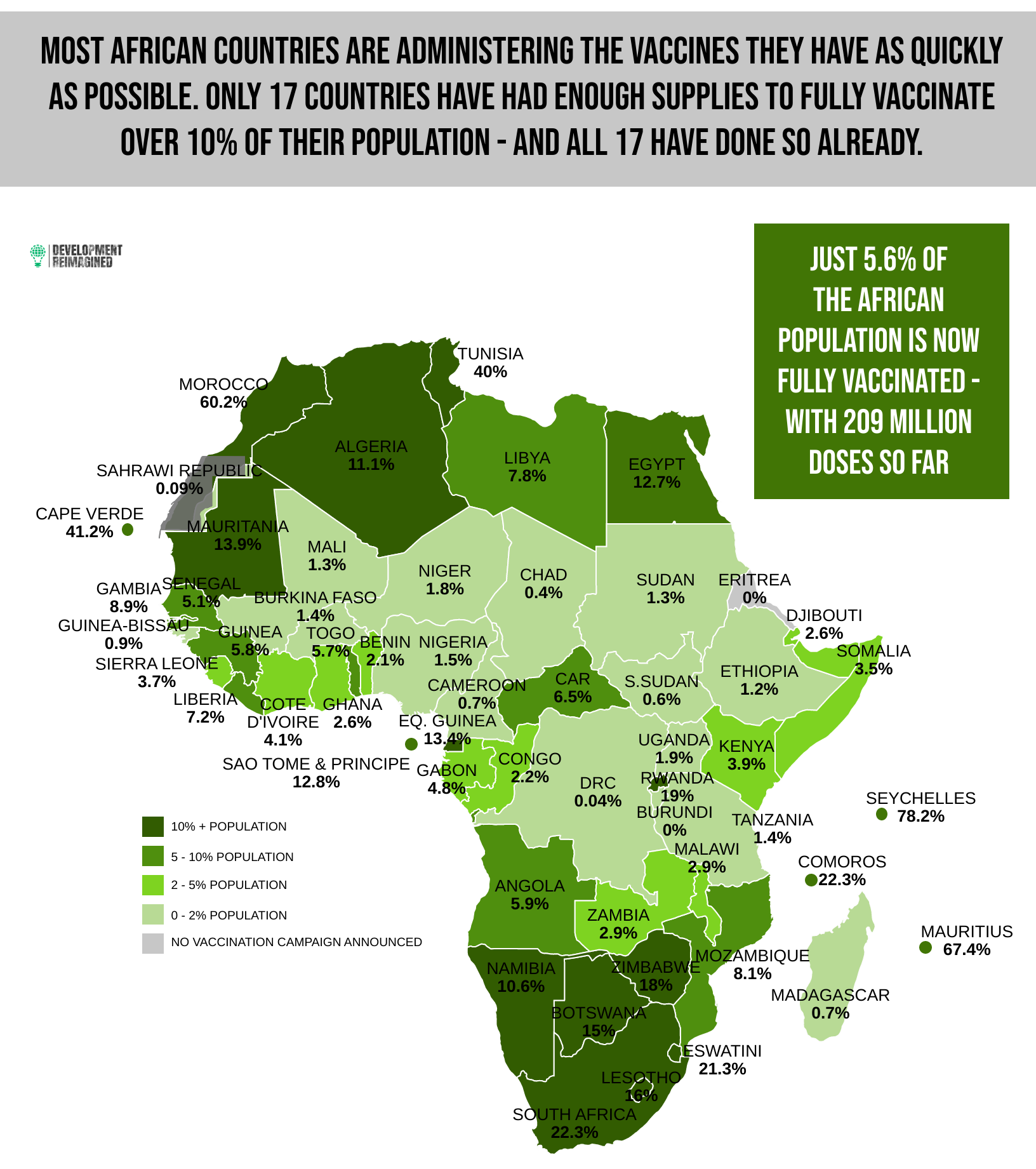Updated Every Month
African Statistics Day is celebrated on the 18 November every year and the use of good reliable data has never been more important. Our research on COVID-19 – utilising public data on case numbers, deaths, social distancing, vaccines and even spending programmes – has been essential to measuring the impact of the health and economic crisis on African countries.
This week, the relaunch of our data-driven research segment on health and development in African countries switches to examine access to public goods. In particular, we ask whether access to public goods on the continent – such as vaccines, renewable energy and international finance – is unusually low.
Throughout this year, we have reported that vaccine delivery to African countries has been consistently slower than the rest of the world, despite African governments making timely orders. Eight months after the first vaccines were delivered to an African country, this trend continues. African countries have still only administered 2.8% of global vaccine supply.
Despite the low number of vaccines delivered, African countries are quickly administering those that they do receive – 17 countries have vaccinated over 10% of their population. This demonstrates that upon receiving public goods, many African governments are swift and effective in ensuring public access to them.
Nonetheless, as the world continues to open up in an apparent post-COVID-19 “recovery”, the continuing low rate of vaccine delivery is a dangerous trend for African countries. To keep cases down without vaccines, economically draining measures such as curfews and lockdowns will continue to be necessary. This is a particular worry for the 10 countries that represent 88.6% of new COVID-19 cases in Africa, and especially if further new strains emerge.
Moreover, a lack of access to vaccines risks overwhelming health systems with high numbers of cases and in turn, leading to high numbers of deaths. Although no African countries have reported morbidity rates from detected cases higher than the worst globally – Peru at 9% -, there are 25 countries with morbidity rates higher than the global average of 2%, meaning low access to vaccines is having an effect. Meanwhile, some countries are rolling out 3rd booster shots.
As we can see from these numbers, public goods like COVID-19 vaccines are essential, but highly constrained when it comes to Africa. It means African countries get left behind.
However, this is not unusual. Unfortunately, the data shows that African countries’ access to other public goods through multilateral cooperation is similarly constrained.
For example, Africa makes up under 2% of global renewable energy production. And almost 70% of this production is concentrated in just three countries. This poor availability of renewables across Africa hinders access to wind, solar, hydropower, and geothermal energy. Renewable energy makes up only 5% of the total energy generation within African countries. This is a small proportion in comparison to Europe (23.8%), North America (13%) and South and Central America (15%).
Access to global financing mechanisms also leaves Africa behind. In the 2021 issuance of new Special Drawing Rights (SDRs), the international community chose not to reallocate SDRs to African countries – hence they in total automatically received under 6% of allocations. This is low in comparison to countries such as the US which alone received close to 20% of the SDR allocation, or Japan and Germany that received around 6% each. This is despite the fact that, as we have shown previously in these graphics, during 2020 African governments were only able to spend an estimated 2.5% of GDP to counter the pandemic, while G20 countries spent over 11% of GDP on their domestic responses.
The fact is, whether we’re discussing COVID-19 vaccines, renewable energy or global financing mechanisms, access to public goods in African countries is constrained, which increases the risk of Africans being left behind.
To deliver on the SDGs or Agenda 2063, the data on Africa Statistics Day 2021 is clear. African governments, think-tanks and civil society organisations must push the multilateral system to make way for proper access to public goods.
To review the data yourself, check out the graphics and numbers below, and do let us know what you conclude, and what you’d like us to find out next time.
 To find out how Development Reimagined can support you, your organisation or Government during the COVID-19 outbreak please email the team at clients@developmentreimagined.com .
To find out how Development Reimagined can support you, your organisation or Government during the COVID-19 outbreak please email the team at clients@developmentreimagined.com .
Special thanks go to Rosie Flowers-Wanjie, Osaru Omosigho, David Tinashe Nyagweta and Jing Cai for their work on the graphics and collecting/analysing the underlying data and this accompanying article.
The data was collated primarily from Africa CDC, as well as other sources including: government websites and media reports, the IMF policy tracker; Worldometer and the New York Times Vaccine Tracker. Our methodology is entirely in-house, based on analysis of vaccine, testing, spending, social distancing, income categories and other trends.
If you spot any gaps or have any enquiries, please send your feedback to us at team@developmentreimagined.com, we will aim to respond asap.
November 2021


